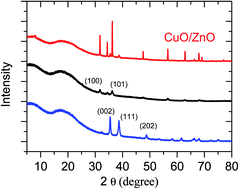Nanoporous hybrid CuO/ZnO/carbon papers used as ultrasensitive non-enzymatic electrochemical sensors†
Abstract
In this research, we demonstrate a facile approach for the synthesis of a graphite-analogous layer-by-layer heterostructured CuO/ZnO/carbon paper using a graphene oxide paper as a sacrificial template. Cu2+ and Zn2+ were inserted into the interlayer of graphene oxide papers via physical absorption and electrostatic effects and then, the Mn+-graphene oxide paper was annealed in air to generate 2D nanoporous CuO/ZnO nanosheets. Due to the graphene oxide template, the structure of the obtained CuO/ZnO nanosheets with an average size of ∼50 nm was duplicated from the graphene oxide paper, which displayed a layer-by-layer structure on the microscale. The papers composed of nanosheets had an average pore size of ∼10 nm. Moreover, the as-prepared CuO–ZnO papers displayed high hybridization on the nanoscale. More importantly, the thickness of the single-layer CuO/ZnO nanosheet was about 2 nm (3–4 layer atom thickness). The as-synthesized nano-hybrid material with a high specific surface area and conjunct bimodal pores could play key roles for providing a shorter diffusion path and rapid electrolyte transport, which could further facilitate electrochemical reactions by providing more active sites. As an electrode material, it displayed high performances as a non-enzymatic sensor for the detection of glucose with a low potential (0.3 V vs. SCE), high sensitivity (3.85 mA mM−1 cm−2), wide linear range (5 μM to 3.325 mM), and low detection limit of 0.5 μM.



 Please wait while we load your content...
Please wait while we load your content...